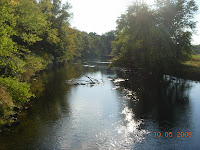
Pond Mud Column
It has been 10 days since I set up my Winogradsky columns. Over this time, the pond mud column has undergone some significant changes. At first, there were thin streaks of black scatter throughout the brown mud in the column. I think that these streaks initiated where the carbon source (grass clippings) were mixed into the mud. As time progressed, the black color overtook the brown color of the mud in the column which can be seen in the photo above. On top of the black layer of mud below the water line, there is a light brown layer that has a slight orange layer within it. The water which was once clear is now discolored. There is also some debris suspended along the sides of the container in the water layer. At this point, there is not a significant difference between the side facing the sun and the side facing away from the sun.

River Mud Column
The changes to the river mud column are much less significant. The water in the column which was clear is now discolored with a greenish hue. Where the mud meets the water, there is a very thin layer of mud that has turned black with orange splotches. There is also orange colored debris suspended in the water. There has not been a significant change in the mud in the rest of the column.






